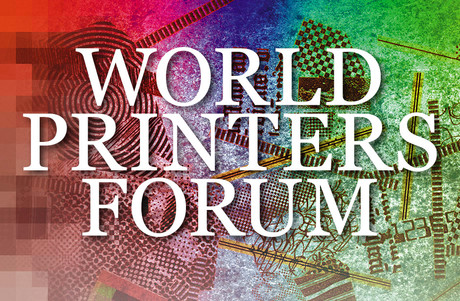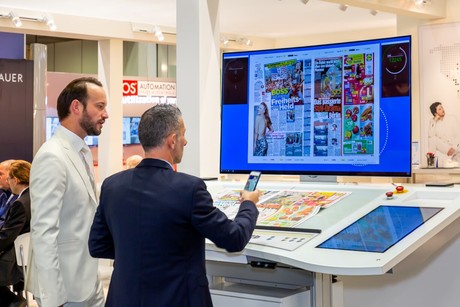World News Publishing Focus: The next edition of the International Color Quality Club 2018-2020 is open not only to newspapers, but also to magazines. What does that mean?
Manfred Werfel: That's right. For the first time since its launch in 1994, not only newspaper titles but also magazines can participate in the print quality contest.
Just a few years ago, by expanding the technical categories, we had also been able to cover newspapers printed on higher paper grades, in addition to coldset newspapers. With the help of dryers and UV systems, many newspapers in the Middle East are mostly produced on SC or LWC paper, for example.
Now we introduce another category for magazines, which may be produced in sheetfed, heatset or gravure. This means that every newspaper and magazine in the world can compete for membership in the International Color Quality Club. To signal this, we have also adapted the name of the competition.
The beauty is: There are now no more restrictions. All newspapers and magazines can participate in this global competition, regardless of their production technology and the materials used, such as paper and ink.
World News Publishing Focus: Why was the scope of the competition extended? Is the world of newspapers no longer big enough?
Manfred Werfel: The world of news has not become too small for us (smirking). The world circulation of printed newspapers is growing year by year, most recently by 5%. But something else has changed. More and more newspaper publishers are investing not only in the digital business, but also in the development of new print products. And more often these new print products are magazines.
For example, a large German quality newspaper started a weekly magazine, then a monthly magazine, and most recently a quarter magazine. All these new magazines are not printed in their own print shop, but the publisher is very attentive to the highest standards of quality. And here the Color Quality Club can play a meaningful role.
The trend towards magazines as products of newspaper publishers can be observed globally. In addition to Europe, the Indian market also plays a leading role here, as is so often the case. From Canada to Australia, printers produce high-quality products in addition to the daily newspaper. Heatset units, UV systems, waterless offset and varnishing units are used in combination with newspaper printing presses to offer a wider range of products, including magazines.
At the WAN-IFRA Publish Asia conference in Kuala Lumpur a few weeks ago, for example, Jon Clarke from Fairfax Media in Australia reported on their new production strategy, which is based on far more flexibility, including heatset and UV options.
World News Publishing Focus: Which companies are expected to register magazines for the competition? Will this be printers or magazine publishers?
Prabhu Natrajan: In principle, both publishers and printers can register one or more publication titles. This applies to newspapers and magazines. At the beginning, we expect newspaper publishers to register some of their magazine titles. But also pure magazine publishers will probably participate in a certain number. I do not expect many independent magazine printers to register their publications for the time being. But all interested parties are of course welcome.
World News Publishing Focus: How is the quality of the submitted journals judged?
Prabhu Natrajan: The print quality is judged in two respects. Firstly, a given print control element, the so-called WAN-IFRA “Cuboid”, is measured by colorimetric measurement technology, not only once, but over the period of three months with at least two samples for each month. So, totally six samples will be evaluated to check and maintain the consistency of the print quality. Secondly, a review of the overall print quality according to established criteria is made by a jury of international experts coming from different world regions. From the overall evaluation, a score is obtained for each publication title. All those publications, who secure a minimum score across all the criteria, will be eligible for ICQC Club membership.
Newspapers that print according to standard conditions of ISO 12647-3 are measured at the target values of this international newspaper printing standard. For magazines, we check the consistency of the print quality of a total of six print samples.
World News Publishing Focus: Why do you check the consistency of print quality in magazines?
Manfred Werfel: In contrast to the standard coldset printing process, the printing of magazines is characterised by a large number of printing processes and substrates. Sheetfed offset as well as web-heatset or gravure printing are used. For the commercial heatset, which is often used for magazine production, the printing standard is ISO 12647-2:2013, but most printers do not yet apply it in practice because the corresponding ICC color profiles are not yet available.
Due to the diversity of the production conditions in the printing of magazines, we have decided to check the consistency of the print samples. All submitted copies are measured colorimetrically. The measured values are then averaged and the deviation of each sample from the mean value is checked. A point score is determined from this, which, together with the points from the jury evaluation, forms the overall result.
World News Publishing Focus: Which key data are important for participation in the next round?
Prabhu Natrajan: Online registration is already possible at colorqualityclub.org. In fact, participants from Brazil, Colombia, Belgium, Germany, Finland and Malaysia have already registered for the International Color Quality Club 2018-2020.
If you register early, you can participate in a free test run, the so-called “Pre-Check” in the autumn of 2017. The printed test form is measured with the original instruments, which are also used later in the competition. Also, all registrants will get pre-measured “Reference Cuboid”, which may be used to compare with your own instruments, will be useful to make decision, whether the instruments needs to be calibrated before even beginning of the contest.
The actual competition starts in January 2018 and requires the submission of monthly test print copies up to and including March 2018. The overall evaluation will be completed in June 2018. Then we also announce the names of the new members of the International Color Quality Club for the next two years. In October 2018 the successful participants will be honoured during IFRA World Publishing Expo in Berlin. Each successful company receives a certificate and pins and can then advertise with the quality award.
World News Publishing Focus: Why do publishers and printers at all participate in the International Color Quality Club, what are the motivations?
Prabhu Natrajan: Participants usually call a number of reasons:
The competition is a good opportunity to motivate the employees once again every two years and to increase the quality awareness in the workforce.
The monthly interim reports during the competition are considered helpful to optimise production processes.
The competition makes it possible to benchmark its own production quality at worldwide standards.
It is also important for many participants to be confident about their confidentiality. We will only announce the successful participants, but not publish the overall list of all participants. This allows any company to participate without fear of being exposed.
As a successful participant, you can then advertise with the quality award of the International Color Quality Club.
You also have got one more reason to motivate yourself and your team. This is the perfect time to standardise print consumables and materials such as newsprint, ink and fountain solution. I still remember the days I worked at newspaper production, we used to keep an eagle eye on newsprint and ink, couple of months before the competition. It’s fact that we standardise the process and material, but rarely monitor and trace the standards.
The International Color Quality Club is the perfect time to re-write the standards of your own process, It’s the time to check how near or far your standards are against ISO and WAN-IFRA standards, it’s the right time to study the different specs of materials and their output in the aspect of quality. In fact, you can trial and error a variety of print materials and papers to arrive at a level, which is in conformance with ISO standards.
No advertisers wants to advertise in a publication, which re-produced it low in quality. It’s time to prove your quality and standards. The biggest motivation of all is convincing your advertiser that you have adopted proven international standards.
Manfred Werfel: And finally, there is another reason to take part in this print quality contest. For every successful participation in a year, a “star” is awarded to the printing company concerned. Once five stars have been collected, the company becomes a member of the WAN-IFRA Star Club. The Star Club is a kind of “Hall of Fame” of the best printers in the world. Stars can also be obtained by acquiring a “Standardised Printing Certificate” from WAN-IFRA. In the meantime, a competition for the leading position in the Star Club has developed. At present, 36 printing companies are represented in the Star Club. The first place is currently marked with 13 stars.
The attractiveness of the International Color Quality Club is also due to the fact that this is the only global quality printing competition for newspapers and magazines and that, unlike many similar regional competitions, it is based on objective measurements and verifiable criteria.





